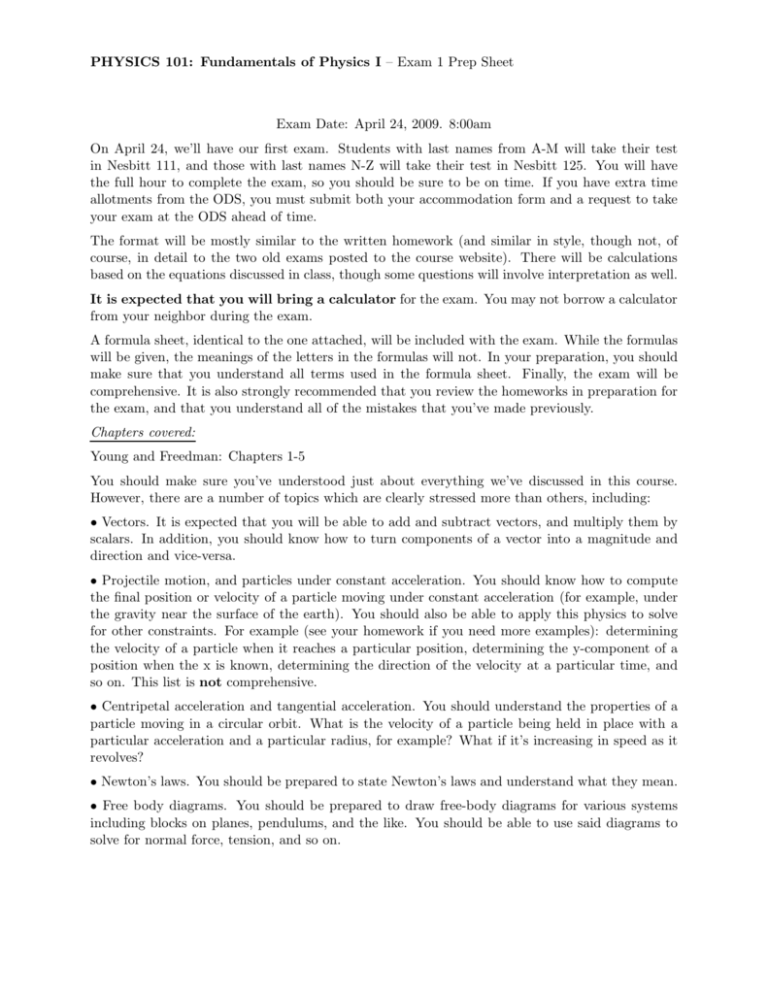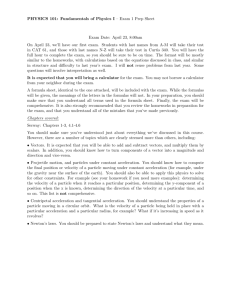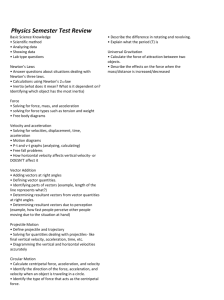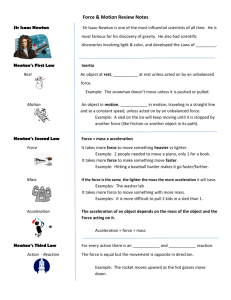PHYSICS 101: Fundamentals of Physics I – Exam 1 Prep Sheet
advertisement

PHYSICS 101: Fundamentals of Physics I – Exam 1 Prep Sheet Exam Date: April 24, 2009. 8:00am On April 24, we’ll have our first exam. Students with last names from A-M will take their test in Nesbitt 111, and those with last names N-Z will take their test in Nesbitt 125. You will have the full hour to complete the exam, so you should be sure to be on time. If you have extra time allotments from the ODS, you must submit both your accommodation form and a request to take your exam at the ODS ahead of time. The format will be mostly similar to the written homework (and similar in style, though not, of course, in detail to the two old exams posted to the course website). There will be calculations based on the equations discussed in class, though some questions will involve interpretation as well. It is expected that you will bring a calculator for the exam. You may not borrow a calculator from your neighbor during the exam. A formula sheet, identical to the one attached, will be included with the exam. While the formulas will be given, the meanings of the letters in the formulas will not. In your preparation, you should make sure that you understand all terms used in the formula sheet. Finally, the exam will be comprehensive. It is also strongly recommended that you review the homeworks in preparation for the exam, and that you understand all of the mistakes that you’ve made previously. Chapters covered: Young and Freedman: Chapters 1-5 You should make sure you’ve understood just about everything we’ve discussed in this course. However, there are a number of topics which are clearly stressed more than others, including: • Vectors. It is expected that you will be able to add and subtract vectors, and multiply them by scalars. In addition, you should know how to turn components of a vector into a magnitude and direction and vice-versa. • Projectile motion, and particles under constant acceleration. You should know how to compute the final position or velocity of a particle moving under constant acceleration (for example, under the gravity near the surface of the earth). You should also be able to apply this physics to solve for other constraints. For example (see your homework if you need more examples): determining the velocity of a particle when it reaches a particular position, determining the y-component of a position when the x is known, determining the direction of the velocity at a particular time, and so on. This list is not comprehensive. • Centripetal acceleration and tangential acceleration. You should understand the properties of a particle moving in a circular orbit. What is the velocity of a particle being held in place with a particular acceleration and a particular radius, for example? What if it’s increasing in speed as it revolves? • Newton’s laws. You should be prepared to state Newton’s laws and understand what they mean. • Free body diagrams. You should be prepared to draw free-body diagrams for various systems including blocks on planes, pendulums, and the like. You should be able to use said diagrams to solve for normal force, tension, and so on. Formula Sheet Physical Constants g = 9.8m/s2 ≃ 10m/s2 c = 3 × 108 m/s Some useful math relations dC dt d(tn ) dt = 0 = ntn−1 x = √ b2 − 4ac 2a −b ± Quadratic F ormula Projectile Relations ∆~r = ~rf − ~ri ~r = xî + y ĵ d~r ~v = dt d~v ~a = dt 1 ~r(t) = ~ri + ~vi t + ~at2 2 ~v (t) = ~vi + ~at vf2 − vi2 = 2ax ∆x Circular Motion ac = at = v = v2 r dv tangential acceleration dt 2πr T Newton’s Laws X ~ F ~ F = m~a = 0 equilibrium











